Heybike has been working hard to become the next household name in e-bikes, and while they may not be there yet, their latest release, the Mars 3.0, is a bold step in the right direction to turn some heads and gain more notoriety.
After the success of the Mars 2.0, Heybike went back to the drawing board and emerged with a version of the Mars that boasts more power, more range, and more features. It’s clear Heybike is trying to make a statement with this one, and on paper, they’re getting it right. After all, we don’t see too many folding e-bikes with full suspension, 1400 watts of power with 95Nm of torque in a package that can throttle beyond 30 mph.
But while “on paper” anything can look impressive, how does it execute in real-world performance where your hard-earned dollars are on the line? After spending a week with the latest Mars, let’s sort out what the bike delivers on, and if anything falls short in this Heybike Mars 3.0 review.
My Experience Riding The Heybike Mars 3.0 E-Bike
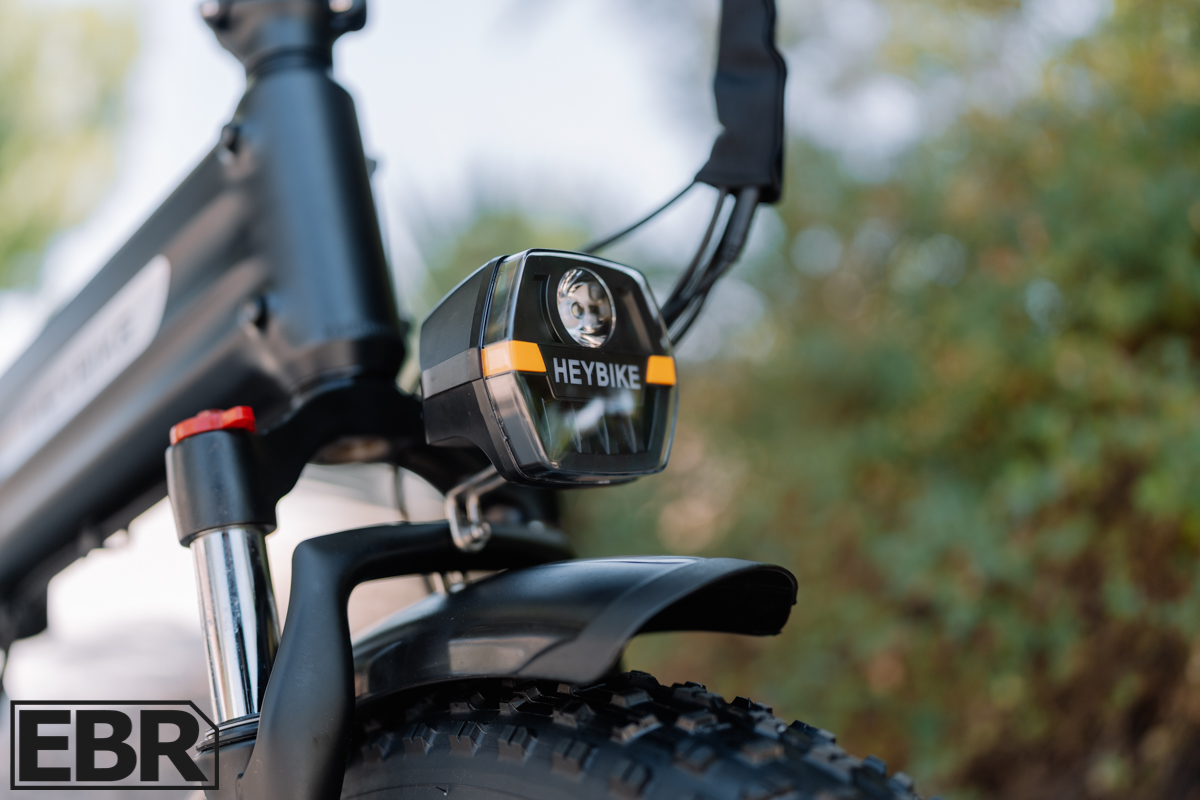
Curb appeal
I was sent the Nightrider black colorway for testing—a virtually blacked-out version of the bike with the only exceptions being chrome accents on the fork stanchions, chain, and Horst linkage.
At 5 ’11”, I found the Mars 3.0 fit me well with plenty of room to adjust in both directions for taller or shorter riders. The front flat bar sits at chest level, and the riding position is mostly upright and comfortable. That comfort is enhanced by the 4-inch wide Chaoyang tires and full-frame suspension consisting of 50mm travel in the front fork plus Horst link rear suspension.
Despite the overall comfort, you do get some audible tire “whine” when riding on paved trails due to the Chaoyang tires’ all-terrain tread pattern. But that’s to be expected—knobby tires on paved surfaces just tend to make noise. I’d rather have the mixed-terrain capability along with a bit of tire noise instead of silent commuter tires that get stuck when I venture off-road from time to time.
The motor is a 750W rear hub unit with a twist throttle that peaks at 1400W and delivers 95Nm of torque, making this one of the more powerful folding bikes available right now. Motor activation is triggered via a torque sensor, and riders have 5 riding modes to cycle through for pedal assistance.
The motor is seriously quick, and I often found myself grinning ear-to-ear only to realize I was throttling around town over 30 mph. This gives the Mars 3.0 the feel of a folding moped more than a traditional folding e-bike. If you like speed, the Mars 3.0 is just plain fun to ride. On the other hand, if that makes you nervous, the bike has a companion app where riders can not only limit the throttle but tune the motor at each level of pedal assist to keep the bike within parameters you’re comfortable with.
The torque sensor on the Mars 3.0 is a nice touch and a welcome upgrade over the previous version’s cadence sensor. In terms of how natural the pedal assistance feels, it’s close but not quite fully dialed in—I could feel the bike doing small surges in power with each pedal rotation, telling me it’s trying to match my effort but just isn’t quite as refined as some others in this price point.
Commuters will love the comprehensive front-to-back lighting that includes not only a headlight, taillight, and brake light but turn signals as well, projecting from the rear taillight corners to let drivers behind you know when you plan to make a turn. Plus, with mounting points for a front rack or basket along with the frame-mounted rear rack, the Mars 3.0 has the build to carry whatever your day has in store.
All in all, the Mars 3.0 is just fun to ride. It’s packed with power and snappy speed, but not so much that you feel like you’ll fly off the back when you start moving. Hit a couple hills though, and you’ll see the Mars 3.0 is packing more power than most folding e-bikes out there as it flattens inclines with relative ease. Even on throttle-only, it’s got the muscle to make quick work of climbs along my route.
Range
Estimated Range (from Heybike):
- Up to 65 miles
Real World Range Test Results:
- MAX PAS Test: 35 miles

Heybike claims the Mars 3.0 can deliver up to 65 miles on a single charge, which would be impressive for any e-bike, let alone a folding one packed with this much power. To put these claims to the test, I ran two separate range tests under different conditions.
My first test used the minimum pedal assist setting, where I managed to squeeze out 54 miles before the battery called it quits. That’s a respectable showing, though it falls about 11 miles short of Heybike’s optimistic estimate. The second test pushed the bike harder using maximum pedal assist, which delivered 35 miles of range—a significant drop but not unexpected given the increased power draw.
As I mentioned in the riding experience section, the torque sensor isn’t quite dialed in yet, with noticeable power surges that suggest the system is working harder than it needs to match my pedal input. This inefficiency likely impacts the overall range potential. An over-the-air update to refine the torque sensor’s responsiveness could help the Mars 3.0 achieve better battery efficiency and potentially get closer to those claimed range figures.
That said, for most riders, getting over 35 miles even on maximum assist—and over 50 miles on efficient settings—is more than adequate for daily commuting or weekend adventures. The range may fall a bit short of the marketing claims, but it’s still competitive in the folding e-bike category, especially considering the power this thing puts out. If you’re planning longer rides, just factor in the realistic range expectations rather than banking on the full 65-mile promise.
Power (Motor & Battery)
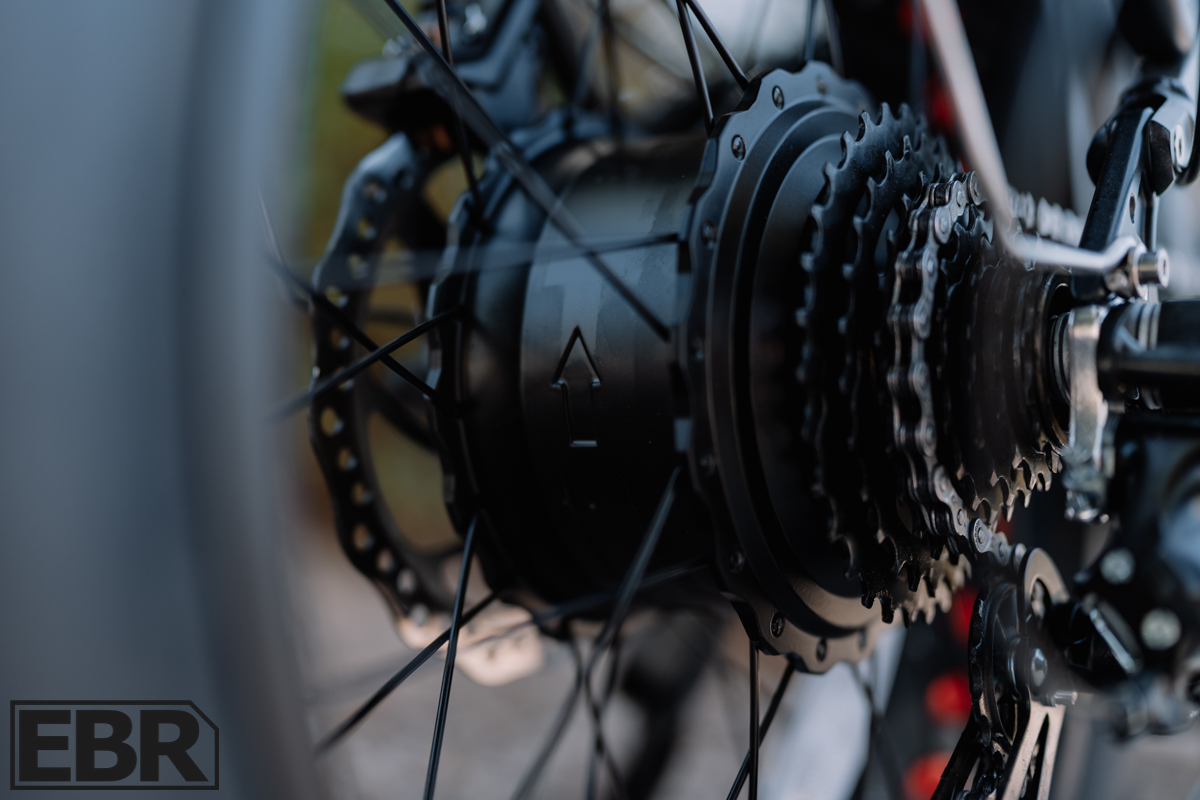
The Mars 3.0 is powered by a rear hub motor paired with a torque sensor and offers five levels of pedal assist: Eco, Tour, Standard, Sport, and Turbo, plus a twist throttle for those times when you don’t want to pedal at all.
While the bike isn’t particularly snappy off the line, it quickly builds momentum thanks to that impressive torque output, and once it gets moving, it’s genuinely quick. What really impressed me was how this folder crushes hills with relative ease—more capability than I’ve seen from any folding e-bike before. Whether you’re tackling steep urban inclines or rolling countryside, the Mars 3.0 has the muscle to flatten them without breaking a sweat.
The companion app adds a nice layer of customization, allowing riders to tune the motor response at each PAS level to dial in a more personalized riding style. The throttle also has a limiter function in the app if you want to reign things in for safety or legal compliance. But for those wondering about full throttle performance, when the limiter is disabled, the throttle was able to push me from 0 to about 32 mph without much effort—that’s serious speed for a folder.
The power comes from a 48V 13Ah 624Wh removable battery that’s fully enclosed within the folding frame. To access it, you’ll find the key slot on the underside of the top tube, but here’s the catch—you need to fold the bike to actually remove the battery from the frame. This setup isn’t ideal for daily battery removers, but it’s a nice option for those who want the security of taking their battery indoors or prefer off-bike charging. The removed battery weighs just under 9 pounds, making it manageable to carry when needed.
Components
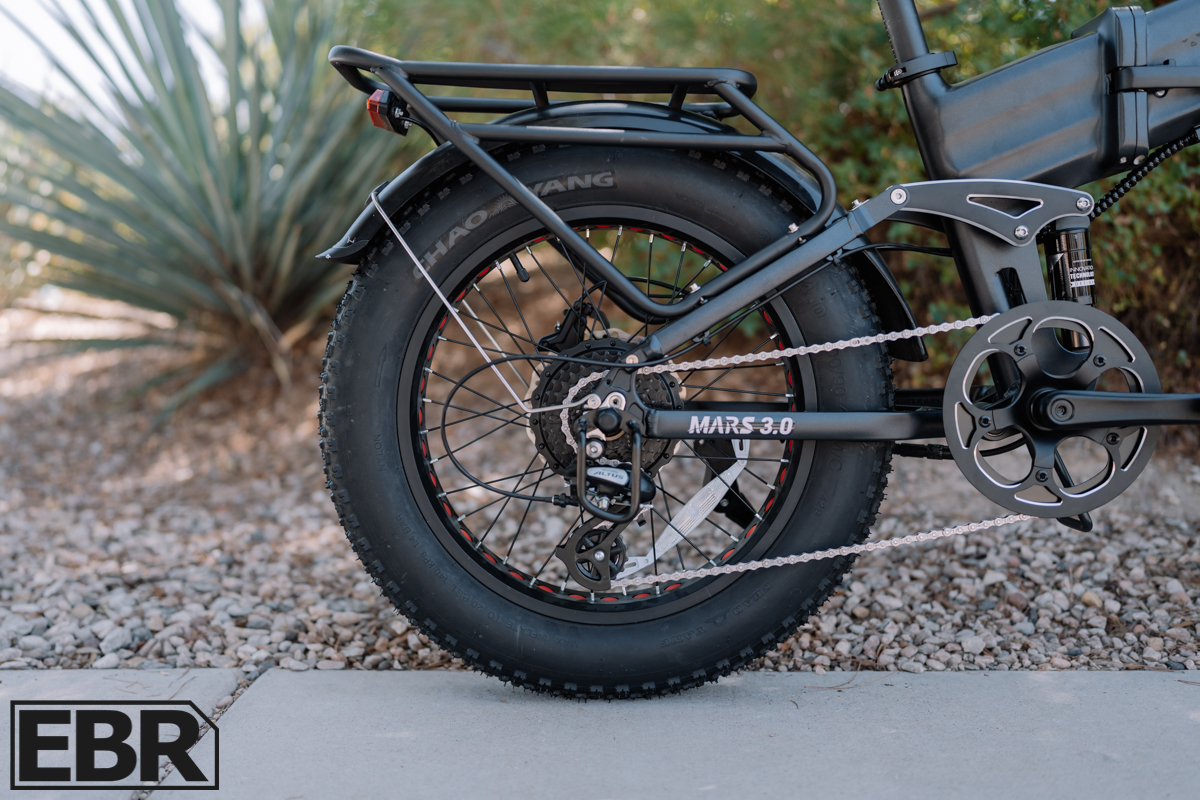
The Mars 3.0 is built around a folding alloy frame with an impressive 440-pound load capacity—more than enough for most riders plus cargo. What sets this folder apart is its full suspension setup: a 50mm travel front fork with coil spring, preload adjustment, and lockout features, paired with a Horst link rear suspension system. This dual-suspension approach is rare in the folding e-bike world and translates to genuine comfort over rough terrain. The lockout feature on the front fork is particularly useful for efficient pedaling on smooth surfaces, while the preload adjustment lets you dial in the suspension for your weight and riding style.
Rolling on 20-inch alloy wheels wrapped in chunky 20″x4.0″ tires, the Mars 3.0 strikes a balance between portability and capability. Those fat tires provide excellent traction and a cushy ride, though as mentioned earlier, they do generate some noise on pavement due to their aggressive tread pattern. The trade-off is worth it for the versatility they offer across different terrain types.
The 8-speed Shimano drivetrain consists of Altus rear derailleur, 8-speed shifters, and a 13-32t cassette paired with a 48t chainring. This setup provides adequate gear range for most riding situations, from steep climbs to flat cruising. The 170mm alloy crankset is standard fare, and the overall drivetrain performs reliably, though it’s clearly positioned as a budget-conscious choice rather than high-performance components.
The telescoping/folding stem pairs with a 25-inch flat bar that offers 5 inches of height adjustability via a quick-release lever—great for dialing in your riding position or accommodating different riders. However, the rubber slide-on grips are a weak point; I’d prefer locking grips as these can rotate and slip over time, especially in wet conditions or during aggressive riding.
The alloy seatpost features quick-release adjustability and a 34.9mm diameter for solid support. The unbranded comfort saddle is surprisingly comfortable for longer rides, though riders with specific preferences may want to swap it out. The flat folding pedals are basic plastic units that do the job but feel a bit cheap—they’re functional for the folding mechanism but could benefit from better materials.
The hydraulic disc brake setup is one of the bike’s stronger component choices. The 2-piston calipers work with 180mm rotors that are 2.0mm thick—a nice touch since the thicker rotors (versus the more common 1.8mm) will dissipate heat better and help extend pad longevity. This translates to more consistent braking performance and less frequent maintenance, which is especially important given the bike’s speed capabilities and weight.
Screen / User Interface / App
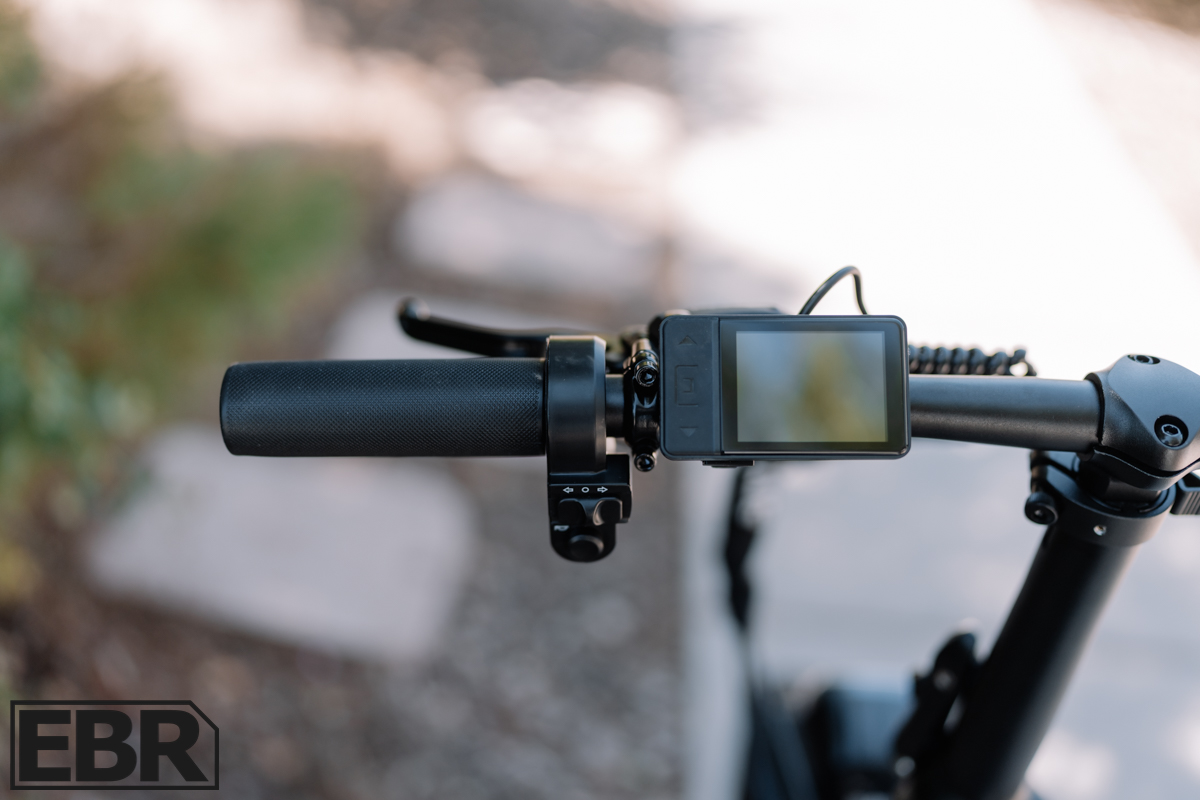
The Mars 3.0 comes with a full-color TFT display that’s both functional and easy to read. With an IP65 rating, it’s well-protected against the elements, so you don’t need to worry about rain or splashing during your rides. One standout feature is the NFC capability for proximity card locking and unlocking—a nice tech touch that adds convenience and security.
The display includes a built-in USB Type-A charging port, which is incredibly handy for keeping your phone or other devices topped up during longer rides. The standard display shows all the essentials: current speed, battery level, remaining charge in volts, odometer, PAS level, and real-time power output. For those who want to dig deeper, holding the ‘+’ and ‘-‘ buttons together for 2 seconds unlocks advanced menus where you can adjust display brightness, units of measurement, wheel size, and other system settings.
The companion app handles GPS ride tracking and motor tuning, with the latter being its main attraction. You can adjust motor response at each PAS level and set speed limiting—features that really help personalize the riding experience to your preferences and local regulations. The app has seen a recent update since my last experience with Heybike products, and I’m happy to report it’s working much better than before, which is a good sign for the brand’s software development efforts.
Perhaps most importantly, the bike can receive over-the-air (OTA) updates through this app, meaning improvements could be coming down the pipeline for the Mars 3.0 as Heybike identifies areas for refinement and rolls out fixes. Given my earlier comments about the torque sensor needing some fine-tuning, this OTA capability could be key to addressing those kinds of issues without requiring a trip to the bike shop.
Heybike Mars 3.0 Model Options
The Mars 3.0 comes in a one-size-fits-most frame that worked well for me at 5’11” with plenty of adjustment range in both the telescoping stem and seatpost to accommodate taller or shorter riders. You’ve got three color options to choose from: Nightrider Black (the stealthy version I tested), Vivid Orange, and Stormy Blue.
Heybike includes a solid accessory package right out of the box. The Mars 3.0 comes with a rear rack mounted directly to the frame, plus mounting points on the head tube for adding a front basket or rack down the line. Plastic fenders front and rear help keep you clean during wet rides, though they’re basic units that get the job done without being particularly robust.
The lighting package is comprehensive and genuinely useful for commuting. You get an adjustable-angle LED headlight up front and a rear rack-mounted taillight that pulls double duty with both brake light functionality and turn signals—a nice touch for urban riding where visibility matters. Being able to signal your intentions to drivers behind you is a safety feature more e-bikes should include.
In the box, besides the bike and accessories listed above, you’ll find an NFC proximity card for quick security access and a 2A charger for topping up the battery.
As for Mars 3.0-specific accessories, Heybike has been keeping quiet about what’s in the pipeline. I wouldn’t be surprised to see the brand release additional accessories as the bike gains traction, but time will tell since we’re still just days away from the official release as I write this review.
Is The Heybike Mars 3.0 Worth Buying?
The Heybike Mars 3.0 is a bike that’s hard to ignore if you’re in the market for a powerful folding e-bike. While Heybike may not be the premium brand some riders are looking for, they’ve clearly put effort into addressing the shortcomings of the Mars 2.0 and delivered something that punches above its weight class.
The standout here is pure performance. With 1400W peak power, 95Nm of torque, and the ability to hit 30+ mph on throttle alone, this thing has more muscle than any folding e-bike I’ve tested. Add in full suspension—a rarity in this category—and you’ve got a folder that can actually handle varied terrain with confidence. The comprehensive lighting package with turn signals and the OTA update capability show Heybike is thinking about real-world usability.
That said, there are some rough edges. The torque sensor needs refinement, the range falls short of claimed numbers, and some components like the slide-on grips feel like cost-cutting measures. The battery removal process isn’t ideal for daily users, and while the app has improved, it’s still not best-in-class.
But here’s the thing—if you want speed and don’t mind a few compromises, the Mars 3.0 delivers where it counts. It’s genuinely fun to ride, handles hills better than folders costing significantly more, and comes loaded with features at what will likely be a competitive price point.
The Mars 3.0 makes sense if you prioritize power and performance over refinement, want full suspension in a folding package, or need something that can double as both commuter and weekend adventure bike. Just go in with realistic expectations about range and know that some fine-tuning may be needed via future updates to reach its full potential.
Pros
- Impressive power output (1400W peak, 95Nm torque) makes for fast flats and hill climbs easy.
- Full suspension is a rare sight in the folding e-bike category, and paired with 4 inch tires, the Mars 3.0 feels up for most challenges.
- Front to Back lighting with turn signals makes city commutes safer with increased traffic awareness.
- Speeds over 30 mph on throttle alone show the Mars 3.0 has the grunt to get up and go when needed.
- App-based motor tuning and customization with over-the-air (OTA) updates to firmware
- NFC based proximity card for quick locking and unlocking on the go.
Cons
- You are required to leave the key in when using the Mars 3.0
- No water bottle cage mounts


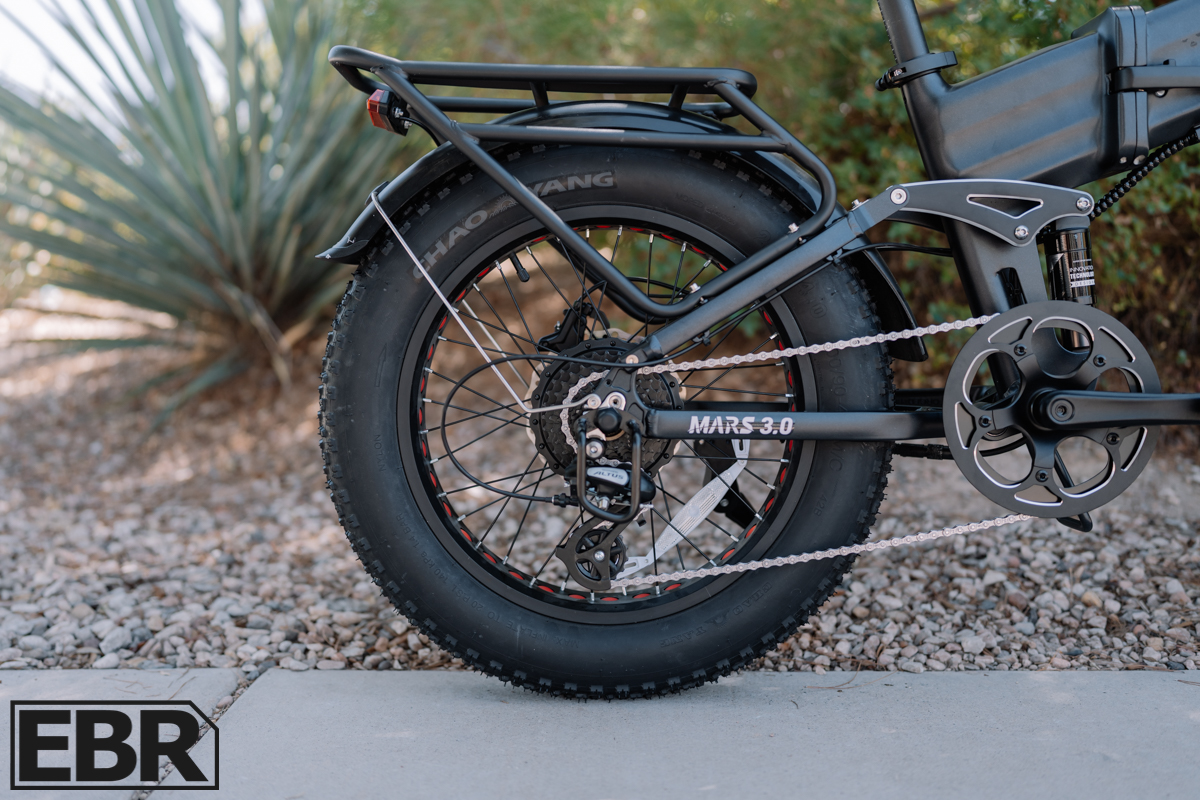
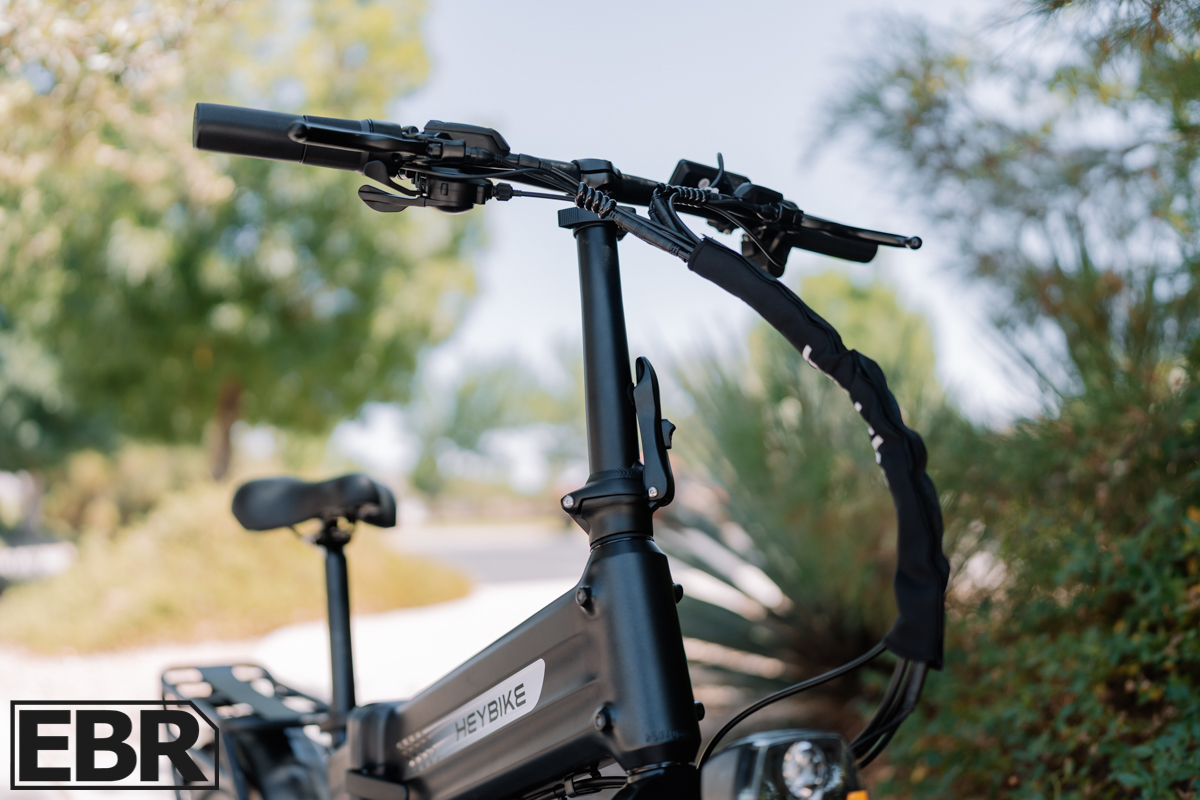
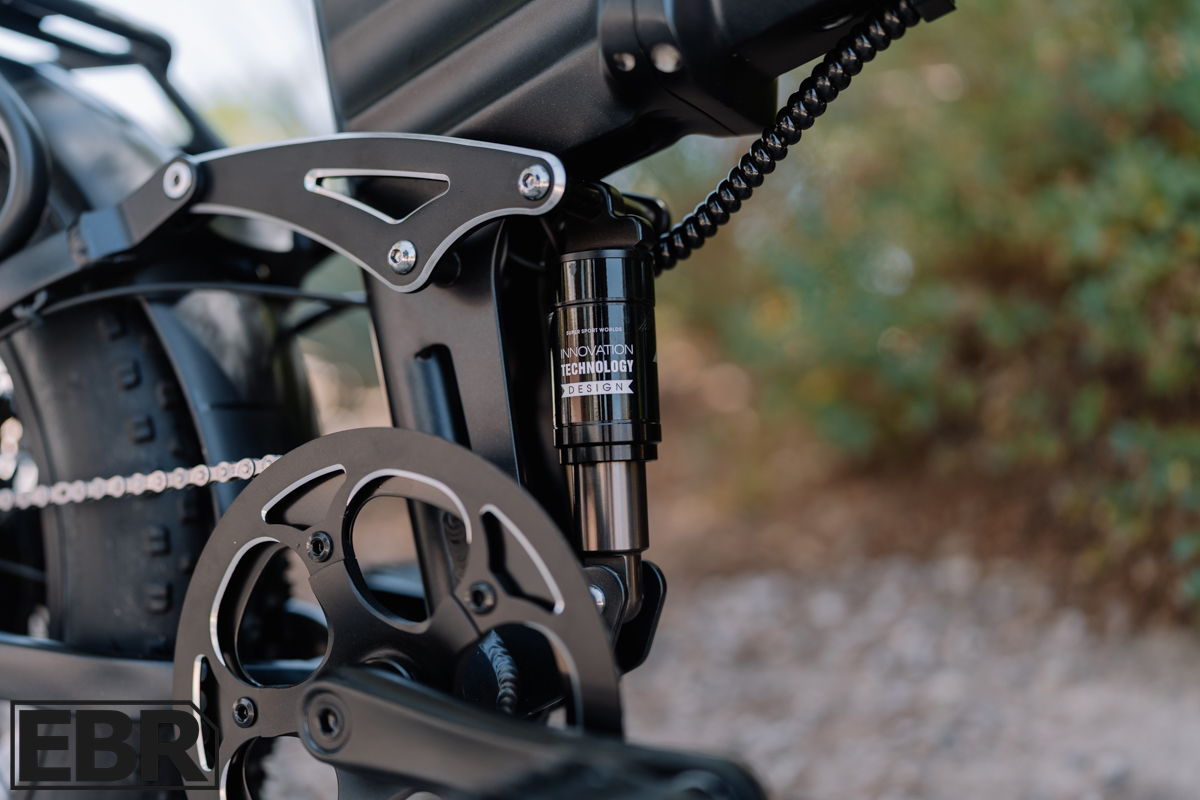
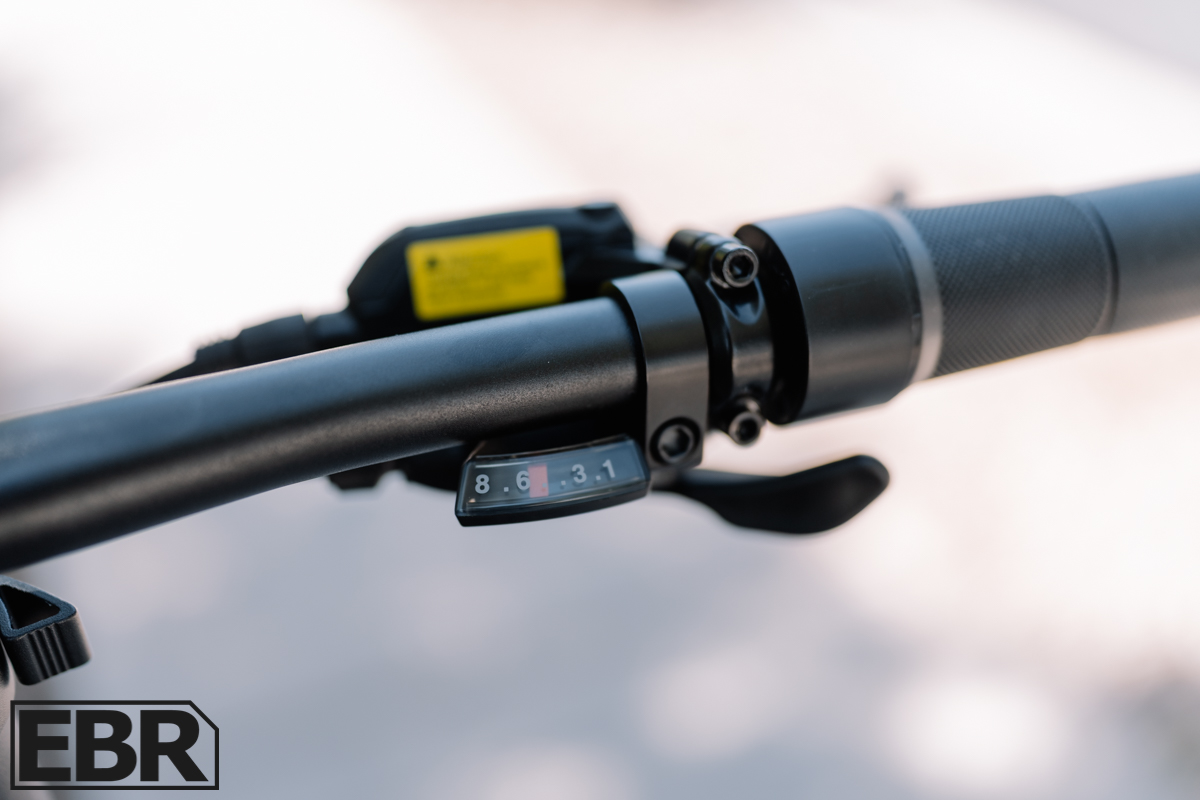


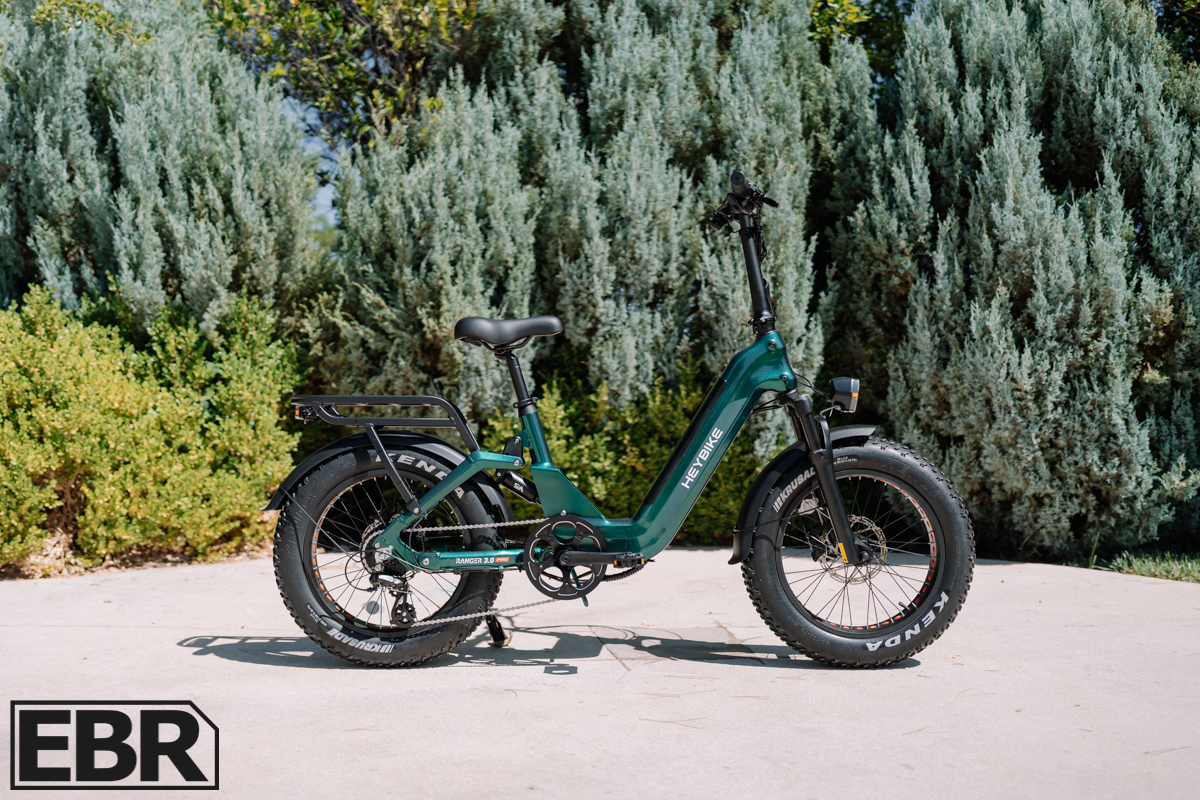
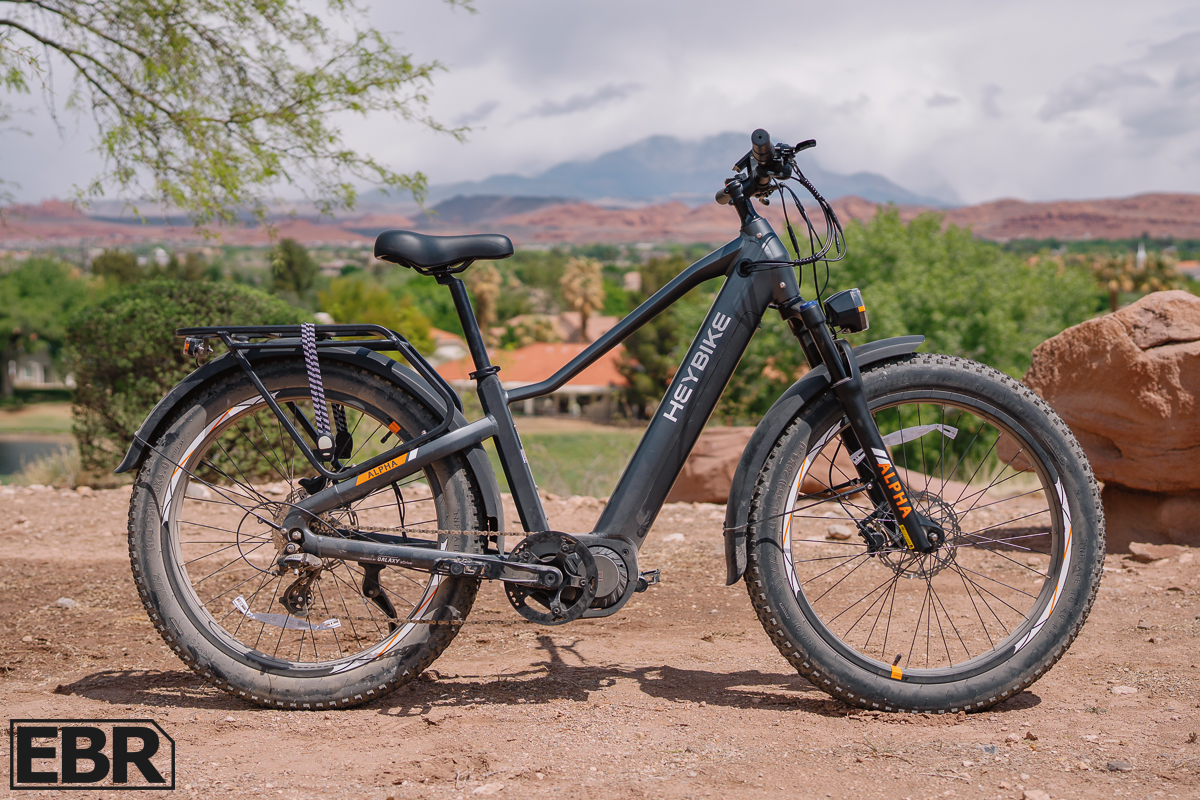
Reader Interactions